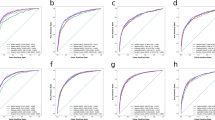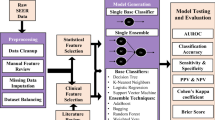Abstract
We assessed prognostic factors in relation to OS from progression in recurrent glioblastomas. Retrospective multicentric study enrolling 407 (training set) and 370 (external validation set) adult patients with a recurrent supratentorial glioblastoma treated by surgical resection and standard combined chemoradiotherapy as first-line treatment. Four complementary multivariate prognostic models were evaluated: Cox proportional hazards regression modeling, single-tree recursive partitioning, random survival forest, conditional random forest. Median overall survival from progression was 7.6 months (mean, 10.1; range, 0–86) and 8.0 months (mean, 8.5; range, 0–56) in the training and validation sets, respectively (p = 0.900). Using the Cox model in the training set, independent predictors of poorer overall survival from progression included increasing age at histopathological diagnosis (aHR, 1.47; 95% CI [1.03–2.08]; p = 0.032), RTOG–RPA V–VI classes (aHR, 1.38; 95% CI [1.11–1.73]; p = 0.004), decreasing KPS at progression (aHR, 3.46; 95% CI [2.10–5.72]; p < 0.001), while independent predictors of longer overall survival from progression included surgical resection (aHR, 0.57; 95% CI [0.44–0.73]; p < 0.001) and chemotherapy (aHR, 0.41; 95% CI [0.31–0.55]; p < 0.001). Single-tree recursive partitioning identified KPS at progression, surgical resection at progression, chemotherapy at progression, and RTOG–RPA class at histopathological diagnosis, as main survival predictors in the training set, yielding four risk categories highly predictive of overall survival from progression both in training (p < 0.0001) and validation (p < 0.0001) sets. Both random forest approaches identified KPS at progression as the most important survival predictor. Age, KPS at progression, RTOG–RPA classes, surgical resection at progression and chemotherapy at progression are prognostic for survival in recurrent glioblastomas and should inform the treatment decisions.



Similar content being viewed by others
Abbreviations
- CRF:
-
Conditional random forest
- IQR:
-
Inter quartile range
- KPS:
-
Karnofsky performance status
- OS:
-
Overall survival
- PFS:
-
Progression-free survival
- RPA:
-
Recursive partitioning analysis
- RSF:
-
Random survival forest
- RTOG:
-
Radiation Therapy Oncology Group
- VIMP:
-
Variable IMPortance
- WHO:
-
World health organization
References
Stupp R, Mason WP, van den Bent MJ et al (2005) Radiotherapy plus concomitant and adjuvant temozolomide for glioblastoma. N Engl J Med 352:987–996. https://doi.org/10.1056/NEJMoa043330
Weller M, Cloughesy T, Perry JR, Wick W (2013) Standards of care for treatment of recurrent glioblastoma–are we there yet? Neuro-Oncol 15:4–27. https://doi.org/10.1093/neuonc/nos273
International Agency for Research on Cancer (2016) WHO classification of tumours of the central nervous system, 4th edn. World Health Organization, Lyon
Lonjon N, Bauchet L, Duffau H et al (2010) Second surgery for glioblastoma. A 4-year retrospective study conducted in both the Montpellier and Nice Departments of Neurosurgery. A literature review. Neurochirurgie 56:36–42. https://doi.org/10.1016/j.neuchi.2009.11.013
De Bonis P, Fiorentino A, Anile C et al (2013) The impact of repeated surgery and adjuvant therapy on survival for patients with recurrent glioblastoma. Clin Neurol Neurosurg 115:883–886. https://doi.org/10.1016/j.clineuro.2012.08.030
Hervey-Jumper SL, Berger MS (2014) Reoperation for recurrent high-grade glioma: a current perspective of the literature. Neurosurgery 75:491–499. https://doi.org/10.1227/NEU.0000000000000486 (discussion 498–499)
Quick J, Gessler F, Dützmann S et al (2014) Benefit of tumor resection for recurrent glioblastoma. J Neurooncol 117:365–372. https://doi.org/10.1007/s11060-014-1397-2
Clarke JL, Ennis MM, Yung WKA et al (2011) Is surgery at progression a prognostic marker for improved 6-month progression-free survival or overall survival for patients with recurrent glioblastoma? Neuro-Oncol 13:1118–1124. https://doi.org/10.1093/neuonc/nor110
Ringel F, Pape H, Sabel M et al (2016) Clinical benefit from resection of recurrent glioblastomas: results of a multicenter study including 503 patients with recurrent glioblastomas undergoing surgical resection. Neuro-Oncol 18:96–104. https://doi.org/10.1093/neuonc/nov145
Woernle CM, Péus D, Hofer S et al (2015) Efficacy of surgery and further treatment of progressive glioblastoma. World Neurosurg 84:301–307. https://doi.org/10.1016/j.wneu.2015.03.018
Helseth R, Helseth E, Johannesen TB et al (2010) Overall survival, prognostic factors, and repeated surgery in a consecutive series of 516 patients with glioblastoma multiforme. Acta Neurol Scand 122:159–167. https://doi.org/10.1111/j.1600-0404.2010.01350.x
Bloch O, Han SJ, Cha S et al (2012) Impact of extent of resection for recurrent glioblastoma on overall survival: clinical article. J Neurosurg 117:1032–1038. https://doi.org/10.3171/2012.9.JNS12504
Barbagallo GMV, Jenkinson MD, Brodbelt AR (2008) “Recurrent” glioblastoma multiforme, when should we reoperate? Br J Neurosurg 22:452–455. https://doi.org/10.1080/02688690802182256
Ening G, Osterheld F, Capper D et al (2015) Risk factors for glioblastoma therapy associated complications. Clin Neurol Neurosurg 134:55–59. https://doi.org/10.1016/j.clineuro.2015.01.006
D’Amico RS, Cloney MB, Sonabend AM et al (2015) The safety of surgery in elderly patients with primary and recurrent glioblastoma. World Neurosurg 84:913–919. https://doi.org/10.1016/j.wneu.2015.05.072
Nieder C, Grosu AL, Molls M (2000) A comparison of treatment results for recurrent malignant gliomas. Cancer Treat Rev 26:397–409. https://doi.org/10.1053/ctrv.2000.0191
Preusser M, de Ribaupierre S, Wöhrer A et al (2011) Current concepts and management of glioblastoma. Ann Neurol 70:9–21. https://doi.org/10.1002/ana.22425
Archavlis E, Tselis N, Birn G et al (2014) Combined salvage therapies for recurrent glioblastoma multiforme: evaluation of an interdisciplinary treatment algorithm. J Neurooncol 119:387–395. https://doi.org/10.1007/s11060-014-1500-8
Archavlis E, Tselis N, Birn G et al (2013) Survival analysis of HDR brachytherapy versus reoperation versus temozolomide alone: a retrospective cohort analysis of recurrent glioblastoma multiforme. BMJ Open. https://doi.org/10.1136/bmjopen-2012-002262
Terasaki M, Ogo E, Fukushima S et al (2007) Impact of combination therapy with repeat surgery and temozolomide for recurrent or progressive glioblastoma multiforme: a prospective trial. Surg Neurol 68:250–254. https://doi.org/10.1016/j.surneu.2006.11.042
Niyazi M, Siefert A, Schwarz SB et al (2011) Therapeutic options for recurrent malignant glioma. Radiother Oncol J Eur Soc Ther Radiol Oncol 98:1–14. https://doi.org/10.1016/j.radonc.2010.11.006
Franceschi E, Brandes AA (2015) The role of bevacizumab in recurrent glioblastoma: new insights from randomized trials. CNS Oncol 4:117–119. https://doi.org/10.2217/cns.15.7
Gorlia T, Stupp R, Brandes AA et al (2012) New prognostic factors and calculators for outcome prediction in patients with recurrent glioblastoma: a pooled analysis of EORTC Brain Tumour Group phase I and II clinical trials. Eur J Cancer 48:1176–1184. https://doi.org/10.1016/j.ejca.2012.02.004
Carson KA, Grossman SA, Fisher JD, Shaw EG (2007) Prognostic factors for survival in adult patients with recurrent glioma enrolled onto the new approaches to brain tumor therapy CNS consortium phase I and II clinical trials. J Clin Oncol 25:2601–2606. https://doi.org/10.1200/JCO.2006.08.1661
Kirkpatrick JP, Sampson JH (2014) Recurrent malignant gliomas. Semin Radiat Oncol 24:289–298. https://doi.org/10.1016/j.semradonc.2014.06.006
Tagliamonte SA, Baayen RH (2012) Models, forests, and trees of York English: was/were variation as a case study for statistical practice. Lang Var Change 24:135–178. https://doi.org/10.1017/S0954394512000129
Stupp R, Hegi ME, Mason WP et al. (2009) Effects of radiotherapy with concomitant and adjuvant temozolomide vs radiotherapy alone on survival in glioblastoma in a randomised phase III study: 5-year analysis of the EORTC-NCIC trial. Lancet Oncol 10:459–466. https://doi.org/10.1016/S1470-2045(09)70025-7
Wen PY, Macdonald DR, Reardon DA et al (2010) Updated response assessment criteria for high-grade gliomas: response assessment in neuro-oncology working group. J Clin Oncol 28:1963–1972. https://doi.org/10.1200/JCO.2009.26.3541
Macdonald DR, Cascino TL, Schold SC, Cairncross JG (1990) Response criteria for phase II studies of supratentorial malignant glioma. J Clin Oncol 8:1277–1280
Mirimanoff R-O, Gorlia T, Mason W et al (2006) Radiotherapy and temozolomide for newly diagnosed glioblastoma: recursive partitioning analysis of the EORTC 26981/22981-NCIC CE3 phase III randomized trial. J Clin Oncol 24:2563–2569. https://doi.org/10.1200/JCO.2005.04.5963
Hothorn T, Hornik K, Zeileis A (2004) Unbiased Recursive Partitioning: A Conditional Inference Framework. http://epub.wu.ac.at/676/. Accessed 25 Sep 2017
Ishwaran H, Kogalur UB, Blackstone EH, Lauer MS (2008) Random survival forests. Ann Appl Stat 2:841–860. https://doi.org/10.1214/08-AOAS169
Breiman L (2001) Random forests. Mach Learn 45:5–32. https://doi.org/10.1023/A:1010933404324
Harrell F (2016) Regression modeling strategies: with applications to linear models, logistic and ordinal regression, and survival analysis. Springer S.l., New York
Hothorn T, Zeileis A (2015) Partykit: a modular toolkit for recursive partytioning in R. J Mach Learn Res 16:3905–3909
Hervey-Jumper SL, Li J, Lau D et al (2015) Awake craniotomy to maximize glioma resection: methods and technical nuances over a 27-year period. J Neurosurg 123:325–339. https://doi.org/10.3171/2014.10.JNS141520
Chaichana KL, Zadnik P, Weingart JD et al (2013) Multiple resections for patients with glioblastoma: prolonging survival. J Neurosurg 118:812–820. https://doi.org/10.3171/2012.9.JNS1277
Goldman DA, Panageas KS (2016) Letter to the editor: biases in estimation of overall survival in patients who underwent repeat resection of glioblastoma. J Neurosurg 125:519–522. https://doi.org/10.3171/2015.11.JNS152515
Acknowledgements
Participating centres (in alphabetical order): Amiens University Hospital—University of Amiens, Angers University Hospital—Angers University, Jean-Minjoz Hospital—University of Besançon, Pellegrin Hospital—University Victor Segalen Bordeaux 2, Morvan Hospital—University of Brest, Assistance Publique-Hôpitaux de Paris Avicenne Hospital—University Paris 13, Caen University Hospital—University Caen Lower-Normandy, Pasteur Hospital in Colmar, Limoges Hospital—University of Limoges, Pierre Wertheimer Hospital—University of Lyon, La Timone Hospital—University Aix-Marseille, Clairval Clinic in Marseille, Guy de Chauliac Hospital—University of Montpellier, Sainte-Anne Hospital Centre—University Paris Descartes, Beaujon Hospital—University Paris Diderot, Maison Blanche Hospital—University of Reims, Pontchaillou Hospital—University of Rennes, Rouen University Hospital—Rouen University, Paul Strauss Cancer Centre—University of Strasbourg, Sainte-Anne Military Teaching Hospital in Toulon, Gustave Roussy University Hospital, Villejuif. These physicians are greatly acknowledged (in alphabetical order): Georges Abi Lahoud, Felipe Andreiuolo, Caroline Apra, Alin Borha, Céline Botella, André Busson, Laurent Capelle, Karl Champeaux, Françoise Chapon, Françine Chassoux, Isabelle Catry-Thomas, Fabrice Chrétien, Philippe Colin, Alain Czorny, Jean-Michel Derlon, Bertrand Devaux, Frédéric Dhermain, Marie-Danièle Diebold, Julien Domont, Hugues Duffau, Sarah Dumont, Myriam Edjlali-Goujon, Jan Eskandari, Anne Fustier, Clément Gantois, Roberto Gadan, Julien Geffrelot, Edouard Gimbert, Joël Godard, Sylvie Godon-Hardy, Marcel Gueye, Jean-Sébastien Guillamo, N Heil, Dominique Hoffmann, Nicolas Jovenin, Michel Kalamarides, Hassan Katranji, Samih Khouri, Maria Koziak, Elisabeth Landré, V Leon, Dominique Liguoro, Guillaume Louvel, Emmanuel Mandonnet, Michael Mann, Eric Méary, Jean-François Meder, Charles Mellerio, Sophie Michalak, Catherine Miquel, Karima Mokhtari, Philippe Monteil, Edmond Nader, Olivier Naggara, François Nataf, Catherine Oppenheim, Isabelle Quintin-Roue, Philippe Page, Philippe Paquis, Delphine Pedenon, Philippe Peruzzi, Tanguy Riem, Valérie Rigau, Odile Rigaux-Viodé, Alain Rougier, François-Xavier Roux, Céline Salon, Etienne Théret, Baris Turak, Denis Trystram, Fanny Vandenbos, Pascale Varlet, Gabriel Viennet, Anne Vital. We would like to thank the Association des Neuro-Oncologues d’Expression Française (ANOCEF).
Author information
Authors and Affiliations
Consortia
Corresponding author
Ethics declarations
Financial disclosures
Johan Pallud, Philippe Menei, Julien Duntze, Antoine Petit, and Philippe Metellus have received honoraria for consultancy from Kyowa Kirin Pharma. Johan Pallud, Johann Peltier, Thierry Faillot, Nicolas Desse, Evelyne Emery, Antoine Petit, Philippe Metellus, Vladislav Pavlov, Olivier Langlois, Alexandre Roux, and Marc Zanello have done speaking engagements (including travel and accommodation) from Kyowa Kirin Pharma.
Rights and permissions
About this article
Cite this article
Audureau, E., Chivet, A., Ursu, R. et al. Prognostic factors for survival in adult patients with recurrent glioblastoma: a decision-tree-based model. J Neurooncol 136, 565–576 (2018). https://doi.org/10.1007/s11060-017-2685-4
Received:
Accepted:
Published:
Issue Date:
DOI: https://doi.org/10.1007/s11060-017-2685-4




